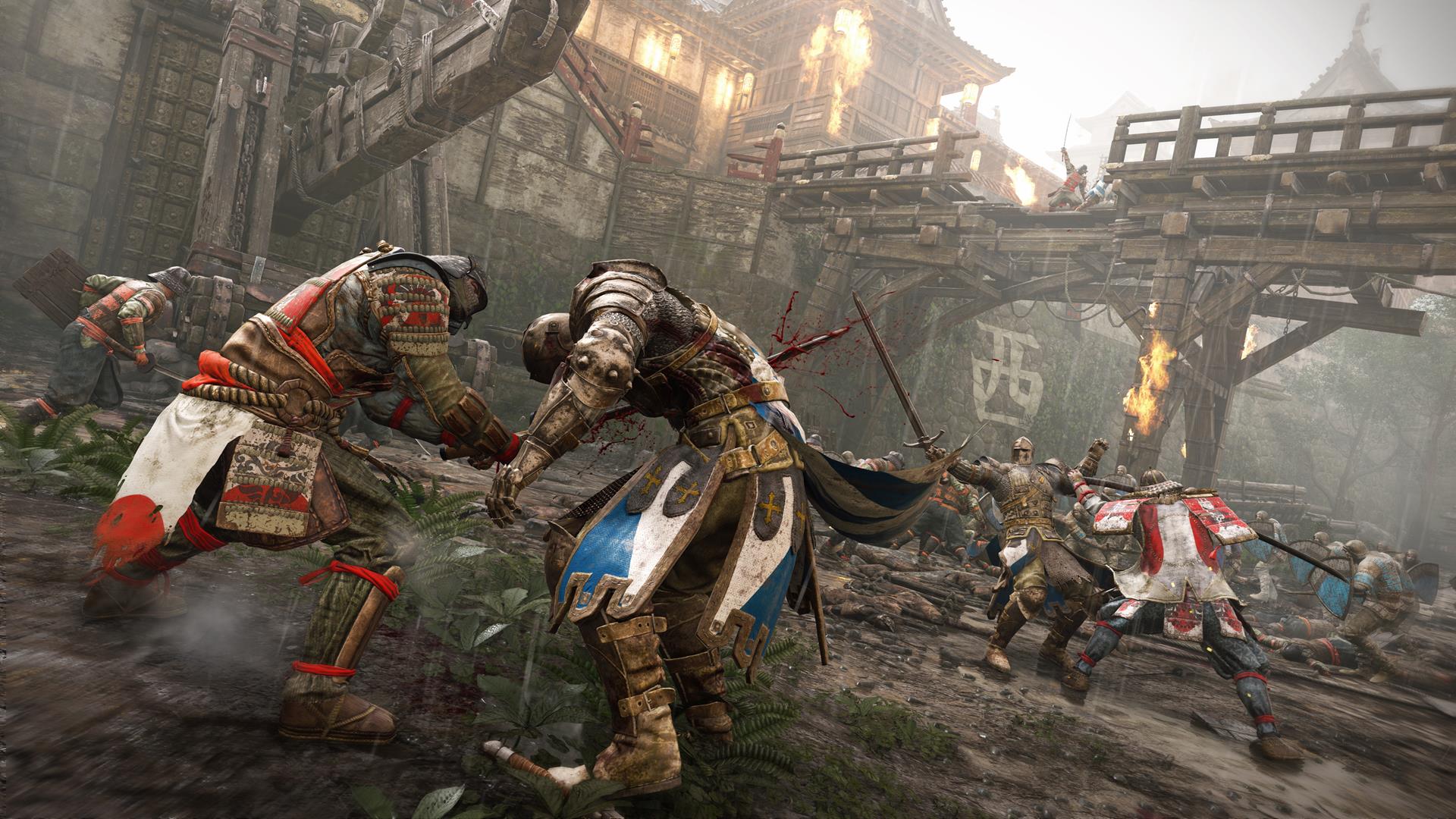For Honor impressions: a Knight, Samurai and Viking walk onto a battlefield
...and you can probably guess what happens next.

The For Honor tutorial is important, but don’t let it mislead you. It spends roughly fifteen minutes teaching you the ropes of this intricate sword fighting sim, pitting you against slow moving or sometimes even static enemies. You learn how to block in three directions, you learn how to attack in three directions, you learn how to dodge and you learn how to guard break. Once done, it’s clear why there is a tutorial: this game takes combat seriously.

Here's a chat with For Honor's creative director Jason VandenBerghe, discussing why it took 14 years for the combat sim to get greenlit.
Then, before the recent closed beta chutes you off into the PvP component, you’re required to face off against an AI opponent in order to test your mettle. The tutorial seemed exhaustive enough. I felt well-tutored. Except this AI bastard slaughtered me quicker than I could let out a stupefied sigh. After gaining the impression that combat would be slow, gruelling, thoughtful, the speed at which this guy floored me was surprising.
The AI was somewhat better than most of the humans I faced during my couple of hours with the game. After all, not many people have played For Honor yet. Most opponents I encountered didn’t seem to know that you could block in more than one direction, and most simply spammed the light attack until I finished them off with a graceful swirl of my sword. As a result, the most important take away from the closed beta is this: if you’re going to play For Honor, play the tutorial and pay attention to it. Otherwise you won’t understand the game, and then you might find yourself hating it.
That is likely to be the main hurdle for For Honor. I suspect it will launch quietly and grow slowly, in much the same way Rainbow Six Siege has done. Split up into three classes including the Samurai, Knights and Vikings, fighting is as much about – if not more about – observing your opponent as it is issuing a blow. You can see in which direction your opponent is guarding with on-screen prompts, and the same holds true for where they’re likely to attack. Victory was a question of how good I was at bluffing my opponent, setting them up for a good solid pounding. The more I could confuse them, the better.
There were three modes available in the closed beta: a 4v4 Dominion mode, which is basically a point capture mode, as well as a 2v2 brawl and a 1v1 duel. Dominion is my favourite, because it’s the most chaotic and purposeful. Despite the minion AI – which can be slayed en masse ala Dynasty Warriors – there’s plenty of tense 1v1 encounters on each of the three capture points. As the minions face off along the centre lane of the map for the main capture point, players tended to focus on the other two points atop nearby platforms.
At least, that’s what usually happened. Sometimes I had matches where people focused on the central capture point, maiming the one-shot-kill minions, rather than worry about the other two tower points. That’s a bit silly: a team must decide whether to spread its resources or gang up on a sole point protector. That kind of collaboration, or awareness, is key. Sure, it’s easy to take down an opponent if two or three are attacking them at once, but capture points accrue rapidly in Dominion. Neglecting other points can turn a sure victory into an embarrassing loss quick smart.

Equally, if you’re being attacked by two human foes at once, it’s usually wise just to run away. Fleeing is a pretty good tactic in For Honor, as much as it often is in League of Legends or Smite. You’re better off staying alive and losing a point than you are waiting for a respawn. Due to the complexities of the combat, and the difficulty of focusing on more than one foe (you can only lock onto one opponent at a time), coordination is important if a heavily guarded point is to be conquered.
Dominion finishes up when a team reaches 1000 points, which is achieved via holding points (naturally) or slaying foes. Although the game focuses on intricate swordplay and requires awareness of your foe’s playstyle, it’s still a breakneck game. That’s best demonstrated in Dominion, but the other modes are decent fun as well, though intermittent server problems (this was a beta, after all) prevented me playing them for long. There’s a vague faction meta which seems geared towards future, seasonal competitions in-game, but at the moment it just seems to be a matter of cosmetic preference.
Will For Honor take off? I hope so. It’s a weird game: you can have a Samurai, Viking and Knight fighting on the same battleground and even in the same team. The combat is complex and satisfying, like a more brutal and brainy rock-paper-scissors. Whether the balancing is right, and whether the meta will evolve in interesting ways, is something we can only wait and see. An open beta kicks off in two weeks, and I’d advise you give it a go.
Keep up to date with the most important stories and the best deals, as picked by the PC Gamer team.

Shaun Prescott is the Australian editor of PC Gamer. With over ten years experience covering the games industry, his work has appeared on GamesRadar+, TechRadar, The Guardian, PLAY Magazine, the Sydney Morning Herald, and more. Specific interests include indie games, obscure Metroidvanias, speedrunning, experimental games and FPSs. He thinks Lulu by Metallica and Lou Reed is an all-time classic that will receive its due critical reappraisal one day.

